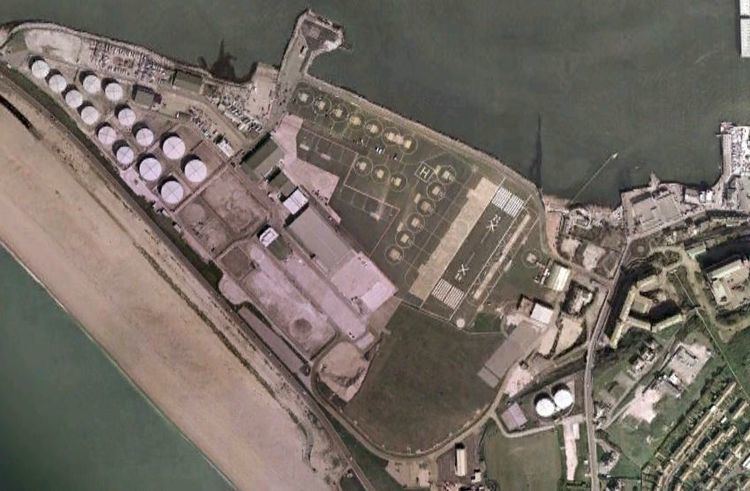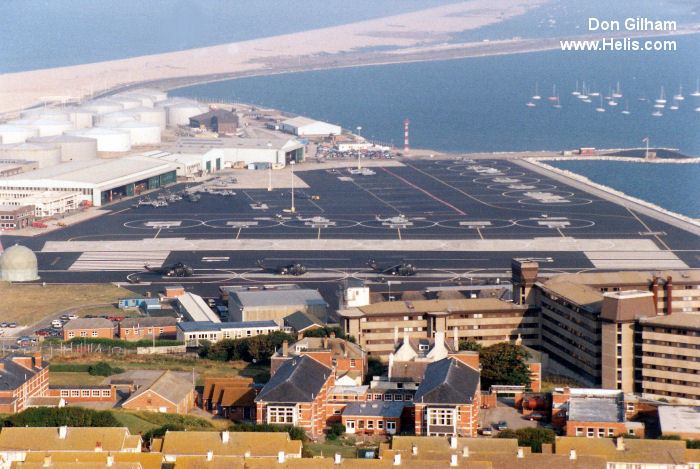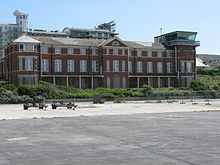Elevation 1 m | In use 1917–1999 (1999) Year built 1917 | |
 | ||
Type Royal Naval Air Station 03/21 230 metres (755 ft) Asphalt | ||
RNAS Portland (ICAO: EGDP) was an air station of the Royal Navy, situated at the Isle of Portland, Dorset, England. It was established in 1917 on the western edge of Portland Harbour as HMS Sarepta. From 1959 the station shared the name HMS Osprey with the anti-submarine establishment located at East Weares, which used the air station's helicopters for research and development in anti-submarine techniques. The establishment operated at Portland between 1924 and 1941, and was recommissioned there in 1946. HMS Osprey and RNAS Portland remained operational until they closed in 1999.
Contents

History

The original seaplane base was first built during World War I, in 1916, as HMS Sarepta. The station used floatplanes, and these flew coastal patrols to protect shipping from German U-boat attacks. In August 1918 HMS Sarepta was taken over by the RAF, and a larger unit of 12 aircraft was formed as No. 241 Squadron RAF. Following the Armistice in November 1918, No. 241 Squadron RAF was disbanded and aviation operations ceased by June 1919.

In September 1939, 772 Squadron, a Fleet Requirements Unit, arrived at Portland and stayed until July 1940. After the inactive inter-war period the base once again became an active flying station. With the fall of France early in the war, the Naval Base at Portland became a prime target for the Luftwaffe. As a result, the continued presence of Portland's anti-submarine school was unfeasible. The school moved to Cambeltown in July 1940, and took 772 Squadron with it. Therefore, Portland's base was held under Care and Maintenance and did not participate on active operations.

After the war the anti-submarine school returned to Portland and a helicopter base became an important centre for the school to perform experiments and development. In 1946 Sikorsky R-4Bs moved in, and the helicopters paved the way for the use of helicopters in the fleet. The success with these trials led the Admiralty to replace fixed-wing aircraft with helicopters, heralding a major building programme at Portland. The base's playing fields were soon taken over as a landing ground and the site became a modern heliport. The old fleet canteen was converted into the headquarters building, operations centre, workshop and control tower.

During the late 1950s the marshy area known as the Mere was filled in and built over, and later expansion meant that this tidal lagoon was completely covered. This created a large concreted area to produce the modern, large helicopter facility. Upon the completion of the work, 815 Naval Air Squadron flew its 12 Westland Whirlwinds to the new Portland Heliport on 14 April 1959. The station was formally commissioned as HMS Osprey on 24 April 1959.

For the next 40 years RNAS Portland was one of the busiest air stations on the south coast, with helicopter operations taking place 24 hours a day. As a helicopter development and training base, it was largely responsible for training aircrew in anti-submarine operations. The site of the base was gradually improved over the years. The airfield was greatly expanded in the 1960s and 1970s, notably between 1967–70, with new hangars. In the 1980s Defence Estates decided to dispose of the Naval ratings married quarters at Weston's Westcliff estate, used by personnel from RNAS Portland. The first disposal took place in October 1986. Following on Mitchell and Shepherd Court were sold in April 1987. In February 1988 the two remaining blocks Hinkley and Odgers Court, were sold.
However, with the reduction of armed forces, it was announced in 1993 the closure of both the naval base and the research establishment on Portland. The harbour closed as a naval base on 29 March 1996, with the Flag Officer Sea Training (FOST) moving to Plymouth's (HMS Drake). With this the RNAS became surplus to the new requirements, and led to its eventual closure on 31 March 1999. RNAS Osprey held its final open day for the public on 17 October 1998.
Following the closure of the base, the site was renamed Osprey Quay, and became an 80 acres regeneration project in 2001. The Weymouth and Portland National Sailing Academy was established in 1999. In 2003 the academy was able to start redevelopment of the site. A SAR helicopter operated by Bristows for the MCA (Maritime and Coastguard Agency) is based at the quay, using a remaining runway. However this helicopter is due to be removed from Portland in 2017.
By 2012 Osprey Quay had been transformed with huge investment, offering over 11 hectares of business space. A significant development of Osprey Quay was the construction of the new Dean & Reddyhoff Marina. The redevelopment of the former RNAS Portland Helicopter Control Tower has also been announced.
With the scheduled removal of the Coastguard Helicopter Service from Portland on 1 July 2017 the site will once again become surplus to requirements and in October 2016 the formal process for the disposal of the site was commenced by the Homes & Communities Agency. With much support from the local MP (Richard Drax) and indeed the local population; HeliOperations; who provide the aircrew that fly the Coastguard helicopters at Portland has won the tender for the purchase of the site and will complete the purchase in June 2017. It is the intention for the company to provide training services for Search & Rescue aircrew and with its strong links with Leonardo, the nearby helicopter manufacturer, it is hoped that once again Portland will become a focus for military helicopter activity.
